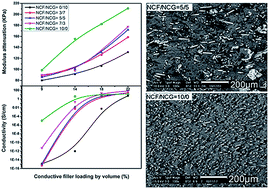Conductivity stability and its relationship with the filler network structure of elastomer composites with combined fibrous/layered nickel-coated fillers
Abstract
Nickel-coated graphite (NCG) with a layered structure and nickel-coated carbon fiber (NCF) with a fibrous structure were simultaneously introduced into a silicone matrix to prepare conductive elastomer composites (CECs) with high electrical conductivity and high conductivity stability. The effects of the volume fraction of fillers, the volume ratio of NCF/NCG, external strain and relaxation time on the conductivity and conductivity stability of the composites were studied. The results showed that the percolation threshold decreased with the increase in volume ratio of NCF/NCG. The conductivity and conductivity stability increased with the increase in the volume fraction of fillers, the volume ratio of NCF/NCG and the relaxation time, but decreased with the increase in external strain. The two dimensional morphology of the conductive filler network was characterized by using environmental scanning electron microscopy and the three dimensional network was characterized by using rubber processing analysis. The relationship between the conductive filler network and conductivity/conductivity stability is established for the first time to provide guidance for the preparation of high performance CECs.


 Please wait while we load your content...
Please wait while we load your content...